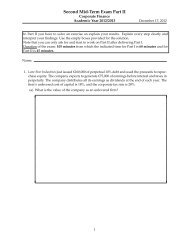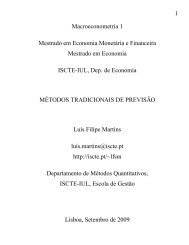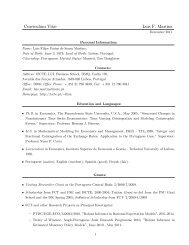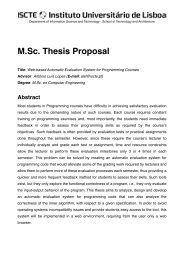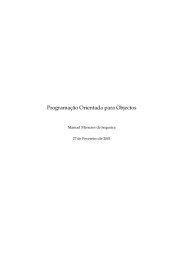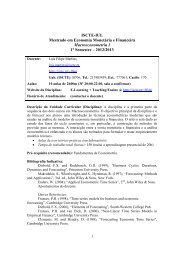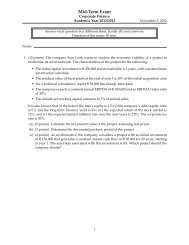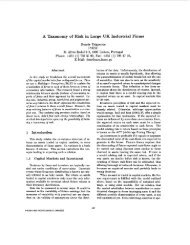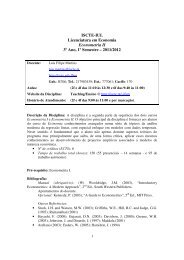The Information Content of Accounting Numbers as Earnings ...
The Information Content of Accounting Numbers as Earnings ...
The Information Content of Accounting Numbers as Earnings ...
You also want an ePaper? Increase the reach of your titles
YUMPU automatically turns print PDFs into web optimized ePapers that Google loves.
Furthermore, we consider that what Ou (1990) describes <strong>as</strong> different cut-<strong>of</strong>f probability schemes<br />
(0.5, 0.5) and (0.6, 0.4) is tantamount to introducing in the outcome, besides the bi<strong>as</strong> referred to<br />
above, yet another arbitrary set <strong>of</strong> a-priori probabilities. Ou’s (1990) cut-<strong>of</strong>f <strong>of</strong> 0.6 means that an<br />
explicit prior probability is added to the logistic output. This renders the model more sensitive to<br />
upwards earnings changes. Similarly, the cut-<strong>of</strong>f <strong>of</strong> 0.4 means that a second prior judgement, contradictory<br />
with the first, is added to the logistic regression output. Sensitivity to downwards<br />
changes also incre<strong>as</strong>es. <strong>The</strong> extra power <strong>of</strong> the models may thus reflect the above prior judgements.<br />
In order to illustrate the potential for unbalancing models which the use <strong>of</strong> non-equal priors<br />
entails, our results are replicated using unbalanced sets <strong>of</strong> priors.. Thus, in our c<strong>as</strong>e, the output <strong>of</strong><br />
the discriminant model, a Z-score, is translated into a binary prediction <strong>of</strong> an earnings incre<strong>as</strong>e or<br />
decre<strong>as</strong>e, using two sets <strong>of</strong> prior probability schemes (0.5, 0.5) and (0.6, 0.4). Under the (0.5, 0.5)<br />
scheme, earnings decre<strong>as</strong>es are a-priori considered <strong>as</strong> equally likely <strong>as</strong> earnings incre<strong>as</strong>es. Under<br />
the (0.6, 0.4) scheme, earnings incre<strong>as</strong>es are considered, a-priori, more likely, thus models are<br />
more sensitive to positive earnings changes.<br />
Model’s results must be validated by me<strong>as</strong>uring its performance in a different data set. Ou (1990)<br />
divided her data set in two periods, 1965-77 and 1978-83, using the first period to build the earnings<br />
prediction model and testing its performance in the second period. However, Freeman et al.<br />
(1982) suggest that the economy, namely macro-economic variables, may have explanatory power<br />
in predicting earnings changes. <strong>The</strong> predictive power claimed by Ou (1990) might then stem from<br />
smoothed economic conditions, not just from genuine accounting information. In our study, the<br />
hypothesis that the economy may interfere with accounting information is made explicit by choosing<br />
the period 1985-88 to build models and the period 1989-93 to test them. <strong>The</strong> first <strong>of</strong> such periods<br />
presents economic conditions which are opposed to those in the second.<br />
Results<br />
Predictive <strong>Information</strong> Link: when we refer to the predictive performance <strong>of</strong> a particular year, it<br />
means that the non-earnings accounting variables <strong>of</strong> that year are used to predict the earnings<br />
changes for the subsequent year. Ratios with overall explanatory power are (Table 1):<br />
Table 1.<br />
Discriminant Two-Period <strong>Earnings</strong> Prediction Model (1985-1988)<br />
Financial Ratios Abbreviation Standardised Coefficient<br />
Dividend per Share DPS +0.63<br />
Sales to Total Assets SALTA +0.52<br />
% Change in Sales to Total Assets % SALTA -0.34<br />
C<strong>as</strong>h to Sales CSHSAL +0.27<br />
Return on Total Assets RTA -0.18<br />
<strong>The</strong> magnitude <strong>of</strong> the standardised coefficient shows the relative explanatory importance <strong>of</strong> each<br />
ratio. A highly significant Chi-Square <strong>of</strong> 45.5 w<strong>as</strong> obtained when estimating the overall fitness <strong>of</strong><br />
the model. Univariate F-ratios <strong>of</strong> each <strong>of</strong> the above predictors are significant, at le<strong>as</strong>t at the 0.05<br />
level, except in the c<strong>as</strong>e <strong>of</strong> C<strong>as</strong>h to Sales (CSHSAL), which is non-significant. However, when<br />
removing this variable from the analysis, a significant break in the overall Chi-Square and performance<br />
is observed. <strong>The</strong> above illustrates just how elusive univariate screening techniques can<br />
be. <strong>The</strong> performance obtained in the test period is 58%, distributed <strong>as</strong> follows (<br />
Table 2):<br />
4






